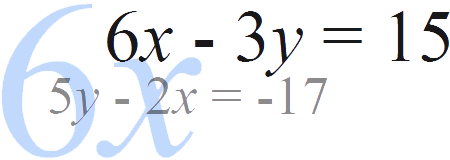Page 4 of 6

Multiply both equations by different numbers to make the number of \(x\)'s or \(y\)'s the same. Then add or subtract the equations to eliminate one of the variables. Solve the following equations:
Question 3
| (a) | \( 2x + 3y = 10\) | (b) | \( 4x - 3y = 11\) | (c) | \( 5x - 7y = 31\) | (d) | \( 3x + 5y = 1\) |
| \( 5x + 2y = 3\) | \( 7x + 2y = 41\) | \( 2x - 3y = 13\) | \( 2x + 2y = 4\) | ||||
| (e) | \( 6x - 3y = 15\) | (f) | \( 4x + 3y = 24\) | (g) | \( 7x + 5y = 38\) | (h) | \( 4x + 7y = 2\) |
| \( 5y - 2x = -17\) | \( 5x + 7y = 37\) | \( 6x + 2y = 28\) | \( 7x + 3y = 22\) | ||||
| (i) | \( 9x - 3y = 81\) | (j) | \( 6x - 4y = -11\) | (k) | \( 3x - 5y = 8\) | (l) | \( 9x + 2y = 39\) |
| \( 4x - 4y = 44\) | \( 4x - 7y = -16\) | \( 7x + 4y = 50\) | \( 4x - 5y = 35\) | ||||
